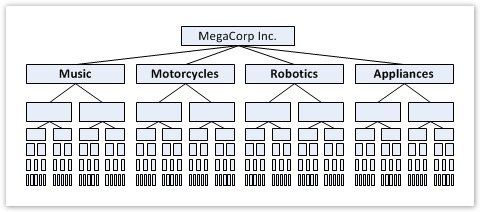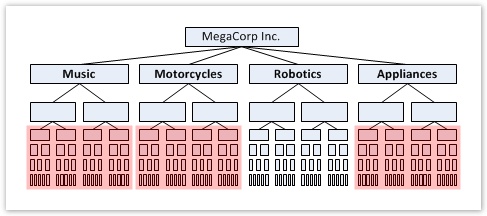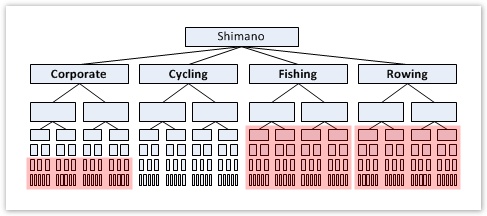...
Suppose again that you’re testing a large corporate site like Sony or MotorolaIBM, with many different business divisions, or perhaps a broad government agency with many different departments.
- diagram or ss of huge tree
...
:
Do you test the entire tree, or just part of it?
...
If you’re really just testing a single section of the big tree, it may still be a good idea to include all the top-level sections anyway, to see if participants can find their content amid the “clutter” of other divisions/departments. In this case, you can safely chop off the sections you’re not interested in at level 2 or 3, because you don’t expect much traffic there (hopefully none at all). Note: don’t cut those sections off at level 1, because participants will quickly figure out that those are just stubs and not where the real action is supposed to be.
For example, if you want to test Robotics, you could abbreviate the other divisions:
In the end, you should only test a subtree by itself if:
- You don’t intend to test content in other parts of the big tree, and
- You’re very sure that participants would choose your subtree every time for each of the tasks you give them, or that they would go to your subtree directly in the real site, bypassing the parent site entirely.
An A real-life example makes this clearer. Suppose we’re testing the Shimano website. Shimano is best known for cycling products (bike pedals, gears, etc.), but they also make equipment for fishing and rowing.
...
If, however, one of your tasks involved finding the story of how Shimano got started in the bike industry, now it’s not so cut and dried. You could imagine some participants going to the Corporate section to find the company’s history. In that case, you might be best to include these top-level sections, include the full Cycling section (obviously), most or all of the Corporate section, and the top level or two of the Fishing and Rowing sections.
- diagram of selectively pruned Shimano tree
...
If you were writing tasks that involved both cycling and fishing, then clearly you would have include all these top-level sections, but you could safely cut the Rowing section short. The bigger problem in this case would be that you’re asking each participant to try both cycling and fishing tasks, and a cyclist (for example) may not know anything about fishing, so their fishing results are going to would be suspect. For more on setting different tasks for different user groups, see Different tasks for different user groups in Chapter 7.
...


